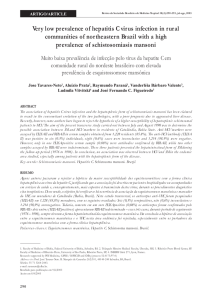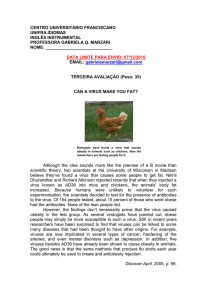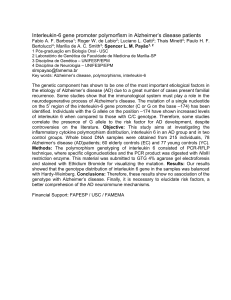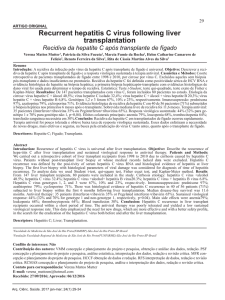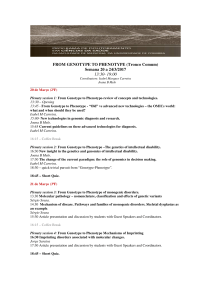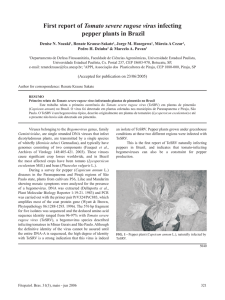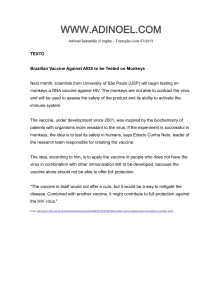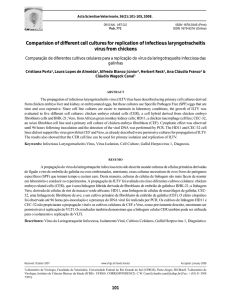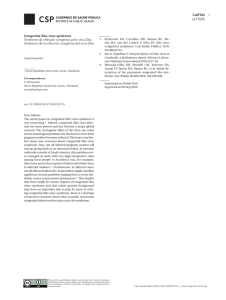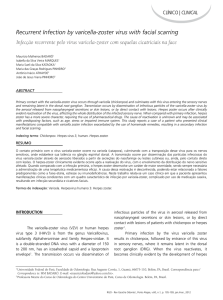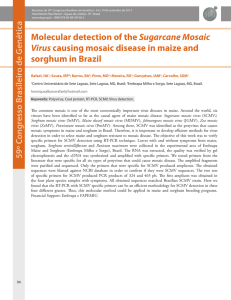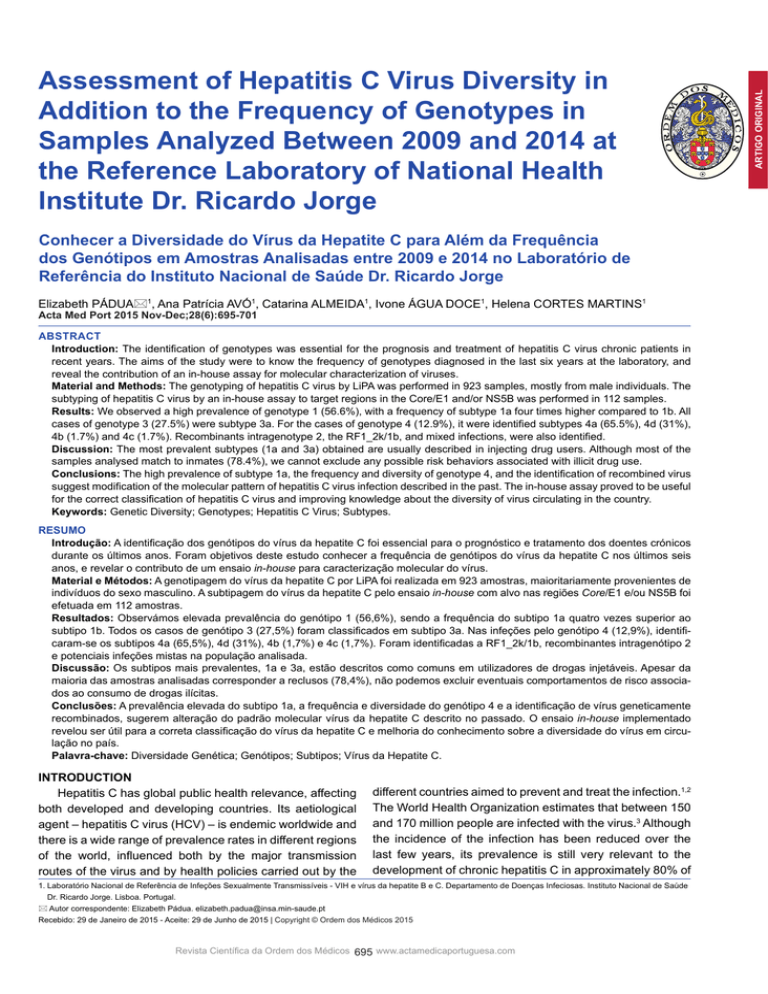
Conhecer a Diversidade do Vírus da Hepatite C para Além da Frequência
dos Genótipos em Amostras Analisadas entre 2009 e 2014 no Laboratório de
Referência do Instituto Nacional de Saúde Dr. Ricardo Jorge
Elizabeth PÁDUA1, Ana Patrícia AVÓ1, Catarina ALMEIDA1, Ivone ÁGUA DOCE1, Helena CORTES MARTINS1
Acta Med Port 2015 Nov-Dec;28(6):695-701
ABSTRACT
Introduction: The identification of genotypes was essential for the prognosis and treatment of hepatitis C virus chronic patients in
recent years. The aims of the study were to know the frequency of genotypes diagnosed in the last six years at the laboratory, and
reveal the contribution of an in-house assay for molecular characterization of viruses.
Material and Methods: The genotyping of hepatitis C virus by LiPA was performed in 923 samples, mostly from male individuals. The
subtyping of hepatitis C virus by an in-house assay to target regions in the Core/E1 and/or NS5B was performed in 112 samples.
Results: We observed a high prevalence of genotype 1 (56.6%), with a frequency of subtype 1a four times higher compared to 1b. All
cases of genotype 3 (27.5%) were subtype 3a. For the cases of genotype 4 (12.9%), it were identified subtypes 4a (65.5%), 4d (31%),
4b (1.7%) and 4c (1.7%). Recombinants intragenotype 2, the RF1_2k/1b, and mixed infections, were also identified.
Discussion: The most prevalent subtypes (1a and 3a) obtained are usually described in injecting drug users. Although most of the
samples analysed match to inmates (78.4%), we cannot exclude any possible risk behaviors associated with illicit drug use.
Conclusions: The high prevalence of subtype 1a, the frequency and diversity of genotype 4, and the identification of recombined virus
suggest modification of the molecular pattern of hepatitis C virus infection described in the past. The in-house assay proved to be useful
for the correct classification of hepatitis C virus and improving knowledge about the diversity of virus circulating in the country.
Keywords: Genetic Diversity; Genotypes; Hepatitis C Virus; Subtypes.
RESUMO
Introdução: A identificação dos genótipos do vírus da hepatite C foi essencial para o prognóstico e tratamento dos doentes crónicos
durante os últimos anos. Foram objetivos deste estudo conhecer a frequência de genótipos do vírus da hepatite C nos últimos seis
anos, e revelar o contributo de um ensaio in-house para caracterização molecular do vírus.
Material e Métodos: A genotipagem do vírus da hepatite C por LiPA foi realizada em 923 amostras, maioritariamente provenientes de
indivíduos do sexo masculino. A subtipagem do vírus da hepatite C pelo ensaio in-house com alvo nas regiões Core/E1 e/ou NS5B foi
efetuada em 112 amostras.
Resultados: Observámos elevada prevalência do genótipo 1 (56,6%), sendo a frequência do subtipo 1a quatro vezes superior ao
subtipo 1b. Todos os casos de genótipo 3 (27,5%) foram classificados em subtipo 3a. Nas infeções pelo genótipo 4 (12,9%), identificaram-se os subtipos 4a (65,5%), 4d (31%), 4b (1,7%) e 4c (1,7%). Foram identificadas a RF1_2k/1b, recombinantes intragenótipo 2
e potenciais infeções mistas na população analisada.
Discussão: Os subtipos mais prevalentes, 1a e 3a, estão descritos como comuns em utilizadores de drogas injetáveis. Apesar da
maioria das amostras analisadas corresponder a reclusos (78,4%), não podemos excluir eventuais comportamentos de risco associados ao consumo de drogas ilícitas.
Conclusões: A prevalência elevada do subtipo 1a, a frequência e diversidade do genótipo 4 e a identificação de vírus geneticamente
recombinados, sugerem alteração do padrão molecular vírus da hepatite C descrito no passado. O ensaio in-house implementado
revelou ser útil para a correta classificação do vírus da hepatite C e melhoria do conhecimento sobre a diversidade do vírus em circulação no país.
Palavra-chave: Diversidade Genética; Genótipos; Subtipos; Vírus da Hepatite C.
INTRODUCTION
Hepatitis C has global public health relevance, affecting
both developed and developing countries. Its aetiological
agent – hepatitis C virus (HCV) – is endemic worldwide and
there is a wide range of prevalence rates in different regions
of the world, influenced both by the major transmission
routes of the virus and by health policies carried out by the
different countries aimed to prevent and treat the infection.1,2
The World Health Organization estimates that between 150
and 170 million people are infected with the virus.3 Although
the incidence of the infection has been reduced over the
last few years, its prevalence is still very relevant to the
development of chronic hepatitis C in approximately 80% of
1. Laboratório Nacional de Referência de Infeções Sexualmente Transmissíveis - VIH e vírus da hepatite B e C. Departamento de Doenças Infeciosas. Instituto Nacional de Saúde
Dr. Ricardo Jorge. Lisboa. Portugal.
Autor correspondente: Elizabeth Pádua. [email protected]
Recebido: 29 de Janeiro de 2015 - Aceite: 29 de Junho de 2015 | Copyright © Ordem dos Médicos 2015
Revista Científica da Ordem dos Médicos 695 www.actamedicaportuguesa.com
ARTIGO ORIGINAL
Assessment of Hepatitis C Virus Diversity in
Addition to the Frequency of Genotypes in
Samples Analyzed Between 2009 and 2014 at
the Reference Laboratory of National Health
Institute Dr. Ricardo Jorge
Pádua E, et al. Genotypes and hepatitis C virus diversity analyzed between 2009 and 2014, Acta Med Port 2015 Nov-Dec;28(6):695-701
ARTIGO ORIGINAL
HCV infection demands further research. 14
The updated version of the commercial assay widely
used for HCV genotyping, known as LiPA, available from
2007, showed a weak performance in subtype determination,
particularly regarding genotype 4 infections. The Portuguese
national reference laboratory within the INSA (National
Health Institute Dr Ricardo Jorge) developed an in-house
assay in 2009 in order to improve HCV classification.15 Our
study aimed to determine the infection’s molecular pattern
over the past six years based on a retrospective analysis of
HCV genotyping obtained between 2009 and 2014, as well
as to improve HCV molecular characterisation in order to
show the contribution of an in-house assay in HCV subtype
determination.
infected patients.2,4
There are few studies in Portugal on HCV infection
and a 1 to 1.5% prevalence is estimated in the Portuguese
population; the virus is associated to 45% of patients with
hepatitis notified in Portugal.5,6 It is however known that
not every patient is notified and many are not diagnosed.
Among the European countries, Portugal has the highest
prevalence rates of this infection (varying between 60 and
80%) in Intravenous Drug Users (or injection drug users IDUs).6-8
HCV is characterised by a great genetic diversity, giving
rise to a high number of virus in circulation, ranked into
seven different genotypes and around 67 viral subtypes.9
Different patterns of epidemiological distribution of the virus
exist worldwide as well as a fast progression rate and the
level of variability significantly increases over time due to
the evolution of HCV quasispecies with an important role
in the natural history of the infection and with the ability to
evade host’s immune response to infection.10
The combined therapy with pegylated interferon alpha
and ribavirin has been used as the standard approach to
chronic patients over the last few years and within the study
period.11 The efficacy of combined therapy, as determined
by the Sustained Virologic Response (SVR), i.e. continued
undetectable HCV RNA at 24 weeks post-treatment,12 ranges
between 42 and 82% and is genotype-dependent. The
lowest SVR rates were found in genotype 1 HCV infections
(40% - 50%) and, in contrast, the highest rates were found in
genotype 2 and 3 infections (80%). Intermediate SVR rates
were associated to genotype 4 HCV infections (43 - 70%).1113
Therefore, different HCV genotypes lead to different
patient’s response to the standard treatment and genotype
identification became crucial for establishing the outcome
and treatment duration. Considering the different clinical
response of patients infected with different subtypes of the
same HCV genotype and the fact that clinical presentation
of subtypes 1a and 1b was already described in literature,
the importance of viral subtype on progression to chronic
MATERIAL AND METHODS
Clinical samples, 2009 - 2014
HCV genotyping using the commercial LiPA assay
was applied to 923 blood samples obtained from patients
presenting with HCV active infection, from which 112 were
selected for viral subtype determination using a new inhouse assay. According to the origin of samples, these were
ranked into three population groups: 724 were included in
the group of ‘prison inmates’, 155 into the group ‘general
population’ (with unidentified risk behaviours) and 44 into
the group of ‘IDU’. As regards gender distribution, 842
samples were obtained from male patients. The average
age of our participants ranged annually between 35.3 and
42.4 (Table 1).
Methodology
Our study involved the retrospective analysis of
HCV genotyping with the commercial VERSANTTM HCV
Genotype 2.0 Assay-LiPA (Siemens Healthcare Diagnostics,
NY, USA) assay and subtype determination with the inhouse molecular assay obtained from the amplification
and sequencing of the Core/E1 and NSSB HCV genomic
regions. The assay’s reaction conditions were already
Table 1 - Characteristics of HCV patients whose blood samples were submitted for genotyping, 2009-2014
Population Group
Total
Men
Women
Average age
General
population
Year
(n)
% (n)
% (n)
(n)
% (n)
% (n)
% (n)
2009
226
93.4% (211)
6.6% (15)
36.5 (110)
10.6% (24)
88.9% (201)
0.4% (1)
2010
214
92.5% (198)
7.5% (16)
35.3 (71)
16.4% (35)
79.4% (170)
4.2% (9)
2011
71
83.1% (59)
16.9% (12)
42.4 (57)
25.4% (18)
38.0% (27)
36.6% (26)
2012
138
92.8% (128)
7.2% (10)
39.6 (116)
16.7% (23)
77.5% (107)
5.8% (8)
2013
140
85.7% (120)
14.3% (20)
41.2 (106)
23.6% (33)
76.4% (107)
0
2014
134
94.0% (126)
6.0% (8)
41.1 (122)
16.4% (22)
83.6% (112)
0
Total
923
91.2% (842)
8.8% (81)
39.9 (582)
16.8% (155)
78.4% (724)
4.8% (44)
Prison inmates*
IDU
* Any possible risk behaviour associated to HCV infection, namely injection drug use, cannot be excluded in this population group
Revista Científica da Ordem dos Médicos 696 www.actamedicaportuguesa.com
Pádua E, et al. Genotypes and hepatitis C virus diversity analyzed between 2009 and 2014, Acta Med Port 2015 Nov-Dec;28(6):695-701
Genotype 1
Genotype 2
Genotype 3*
Genotype 4§
Inconclusive¶
Year
% (n)
% (n)
% (n)
% (n)
% (n)
2009
52.3% (134)
1.8% (4)
27.4% (62)
11.0% (25)
0.4% (1)
2010
57.9% (124)
2.3% (5)
21.0% (45)
15.9% (34)
2.8% (6)
2011
57.7% (41)
0
21.1% (15)
15.5% (11)
5.6% (4)
2012
51.4% (71)
0
35.5% (49)
12.3% (17)
0.7% (1)
2013
50.7% (71)
0.7% (1)
33.6% (47)
14.3% (20)
0.7% (1)
2014
60.4% (81)
2.2% (3)
26.9% (36)
8.6% (12)
1.5% (2)
Total
56.6% (522)
1.4% (13)
27.5% (254)
12.9% (119)
1.6% (15)
* All samples were classified as subtype 3a; § Includes non-subtyped genotype 4 infections and indistinguishable subtype 4a/4c/4d infections; ¶ Six patients with multiple infections
with different HCV genotypes are included: genotypes 1 and 3, 1 and 4 and genotypes 3 and 4.
described.15
RESULTS
HCV Genotyping
The genotyping results obtained over the six-year period
of the study showed a higher frequency of genotype 1
infections (56.6%, range 50.7-60.4%), followed by genotype
3 (27.5%, 21.0-35.5%) and genotype 4 (12.9%, 8.6-15.9%).
Genotype 2 was the least frequent (1.4%, 0-2.3%) and
no patients infected with genotypes 5, 6 or 7 were found
(Table 2). In addition, 1.6% of the results were inconclusive
with the LiPA method, including six patients infected with
different HCV genotypes, namely genotypes 1-3, 1-4 and
3-4.
Genotype 2 HCV infection was rare and 1 and 3 were
the most prevalent over the six-year period of the study,
with a similar frequency, irrespective of the group (general
140
population, prison inmates or IDU) (Fig.1, Table 2). In
addition, a 12.9% average frequency of genotype 4 HCV
infection was found, showing a rising tendency between
2009 and 2013, from 11 to 14.3%, respectively (Table 2).
HCV subtyping
From all the patients infected with genotype 1, we found
that approximately 80.8% (422/522) were infected with
subtype 1a and 17.0% (89/522) with 1b. The HCV subtype
was not established in 2.1% (11/522) of the patients with
the LiPA commercial assay and the ratio between subtype
1a and 1b frequencies was sustained on each year and
over the six-year period of the study, always showing
approximately a four-fold higher frequency of patients
infected with subtype 1a (Fig. 2).
Subtype 3a was the only found within the genotype 3
samples, corresponding to 27.5% of the samples (Table 2).
52.3%
57.9%
120
100
60.4%
80
60
51.4%
50.7%
27.4%
21.0%
40
15.9%
35.5%
33.6%
57.7%
26.9%
11.0%
20
1.8%
0
2009
Genotype 1
2.3%
0%
2010
2011
Genotype 2
14.3%
12.3%
21.1%
15.5%
0%
8.6%
2.2%
0.7%
2012
2013
Genotype 3
Figure 1 - Comparison of HCV genotypes determined by the commercial assay LiPA, 2009-2014
Revista Científica da Ordem dos Médicos 697 www.actamedicaportuguesa.com
Genotype 4
2014
ARTIGO ORIGINAL
Table 2 - Annual variation of HCV genotype percentages obtained by LiPA, 2009-2014
Pádua E, et al. Genotypes and hepatitis C virus diversity analyzed between 2009 and 2014, Acta Med Port 2015 Nov-Dec;28(6):695-701
ARTIGO ORIGINAL
We were unable to establish the HCV subtype in 156
(16.9%) of the 923 samples using the LiPA commercial
assay: subtype was indistinguishable in 114 (73.1%) and
indeterminate in 42 (26.9%).
The samples in which we were unable to reach any
subtype determination and with sufficient serum remaining
were submitted (n = 83) for amplification and sequencing
of Core/E1 and/or NS5B HCV genomic regions with the inhouse assay and were successfully subtyped. Therefore, in
the group of non-subtyped samples infected with genotype
4 (n = 55) with the LiPA assay, subtype 4a was the most
common (65.5%), followed by subtype 4d (32.7%); one
sample with subtype 4c was also found (Table 3 and Fig.
3). In addition, one sample was classified as subtype 4b
with the in-house assay, whilst having been classified
as indeterminate with the LiPA assay (Table 3). It should
be also mentioned that the molecular assay found the
inter-genotypic recombinant RF1_2k/1b and three intragenotype 2 HCV strains (phylogenetic estimation, data
not presented), not yet described in the international HCV
sequence database (Table 3).
DISCUSSION
Portuguese studies on HCV molecular epidemiology are
scarce and the prevalence of viral genotypes and subtypes
in the infected Portuguese population is still poorly known.
Therefore, our retrospective study developed at INSA’s
reference laboratory, involving a HCV detailed molecular
characterisation, can make a great contribution to increasing
knowledge regarding the virus diversity in Portugal,
particularly in the population groups where samples came
from, including temporal changes in molecular patterns of
infections.
Genotype 1, 2 and 3 HCV infections have been described
as the most prevalent worldwide, namely in the European
and American continents.16,17 A clinical trial carried out by
Portuguese researchers around 15 years ago18 already
showed a high prevalence of genotype 1 (mostly associated
to subtype 1b) and a significant frequency of subtype 3a. A
low frequency of genotype 2 infection and no patient infected
with genotype 4 were described. More recent retrospective
studies on HCV molecular characterisation developed in
IDU population groups and in prison inmates15,16 found a
predominance of subtypes 1a and 4a in genotype 1 and
4 infections, respectively. A low frequency of genotype 2
was found in all studies. Our study has confirmed a high
prevalence of genotype 1 (subtype 1a) and 3 (subtype 3a)
and also showed that genotype 2 infection is still sporadic.
A possible increase in genotype 4 infections, observed
between 2009 and 2013, was also suggested.
Epidemiological studies showed that subtype 1b is
highly prevalent worldwide and widely spread in Europe
and in some African countries, as well as in some Southeast
Asian countries, associated to elderly patients having
contracted the disease through blood transfusions in the
past.6,16,17 Despite the selection bias, we have found in our
study that subtype 1b showed a four-fold lower frequency
when compared to subtype 1a, mainly related to young
inmate patients.
Subtype 3a was the second more frequent in our
population and, as subtype 1a, was described as frequently
found in IDUs from different European countries.16,17,19
Nevertheless, despite most patients in our study were
prison inmates, the possible risk behaviours associated
to the use of illicit drugs cannot be excluded in the IDU
population group.
Genotype 4 is prevalent in the Middle East and in Africa
and is associated to 62 and 90% of the infections observed
140
120
100
25.4%
15.6%
80
12.2%
60
40
74.6%
19.4%
16.9%
80.6%
83.1%
2012
2013
84.4%
14.3%
20
87.8%
85.7%
0
2009
2010
2011
Subtype 1a
Subtype 1b
Figure 2 - Comparison of subtypes 1a and 1b in HCV-infected patients, 2009-2014
Revista Científica da Ordem dos Médicos 698 www.actamedicaportuguesa.com
2014
in Saudi Arabia and in Egypt, respectively. Studies showed
that genotype 4 remained endemic for a long period
of time in Central and Western Africa, supported by
continuing traditional practices including circumcision and
scarification or by sexual transmission. Spreading to other
African regions has coincided with the massive vaccination
campaign carried out between 1920 and 1940.13,20 HCV’s
high genetic diversity observed in Sub-Saharan Africa led
to the hypothesis that genotype 4 was originated in Central
and Western Africa and subsequently spread across the
continent.13,17,20,21 A homogeneous molecular pattern was
found in Egypt, with the predominance of subtype 4a, unlike
the heterogeneity of genotype 4 variants in circulation in
Sub-Saharan Africa; blood transfusion was described as the
most frequent route of transmission until a few years ago.
In addition, the predominant subtypes in Saudi Arabia were
4c/4d, followed by 4h, 4e and 4a, suggesting the presence
of potential differences regarding viral origin or transmission
routes in this country. An increased prevalence of subtypes
4d and 4a was described in European countries, namely
in Spain, France, Italy and in Greece, associated to the
movement of IDUs and to migrants arriving in Europe from
endemic countries.20,21 Our study found a relatively high
prevalence of subtype 4a, followed by subtype 4d and only
Table 3 - HCV classification with the commercial assay LiPA and the new in-house assay
LiPA vs 2.0
Sequencing of Core + E1 and/or NS5B HCV regions
(5’UTR + core)
1a
1b
2k/1b*
2
1
7
4
1a
10
1b
12
2
2a/2c
2b
3a
Total
2a
2b
3a
4a
4b
4c
4d
n
11
10
12
1
1
2
4
1
2
2
5
1
1
6
6
4
4
3
7
4a/4c/4d
32
1
15
48
Inconclusivo
1
2
2
2
1
8
Total (n)
18
18
1
3
3
3
8
38
1
1
18
112
§
* Sequences were classified as RF1_2k/1b, which is a recombinant strain described by Kalinina et al. 200223; § Intra-genotype 2 recombinant strains were identified with other
molecular studies.
32%
64%
2%
2%
Subtype 4a
Subtype 4b
Subtype 4c
Figure 3 - Comparison of subtypes 4a, 4b, 4c and 4d in HCV-infected patients, 2009, 2014
Revista Científica da Ordem dos Médicos 699 www.actamedicaportuguesa.com
Subtype 4d
ARTIGO ORIGINAL
Pádua E, et al. Genotypes and hepatitis C virus diversity analyzed between 2009 and 2014, Acta Med Port 2015 Nov-Dec;28(6):695-701
Pádua E, et al. Genotypes and hepatitis C virus diversity analyzed between 2009 and 2014, Acta Med Port 2015 Nov-Dec;28(6):695-701
ARTIGO ORIGINAL
observed with the in-house assay. In addition, subtype 4b
was also found, which was already described in Portugal,22
as well as subtype 4c. These results showed the presence
of a high genetic diversity of genotype 4 in Portugal.
The first HCV recombinant strain was identified in 2002
in S. Petersburg - RF1_2k/1b;23 subsequent studies showed
its spreading in IDUs from different European countries.24
The in-house assay used in our study allowed the detection
of one patient infected with the RF1_2k/1b and three patients
with the intra-genotype 2 variant (data not presented). In
fact, several patients infected with a particular recombinant
HCV strain were found in some Portuguese studies,15,16
explaining for the monitoring of the molecular epidemiology
of the infection as well as its dynamics and the study of the
possible clinical impact of these viral variants, even though
a low HCV recombination frequency has been described in
literature.
CONCLUSIONS
Despite our selection biased population, we found in
our retrospective analysis that subtype 1a was the most
frequent over the last six years, four times more frequent
than subtype 1b. In addition, genotype 2 was sporadic
and subtypes 2a and 2b were identified. Genotype 3 was
exclusively classified into subtype 3a, whilst genotype 4
infection was relatively frequent and characterised by a high
viral diversity and subtypes 4a, 4b, 4c and 4d were found.
Patients infected with HCV recombinant strains were also
found.
The HCV pathogen-associated molecular pattern
obtained in our study is consistent with an epidemics
associated illicit drug use risk behaviours, which has been
frequently described in Portuguese IDU population groups.
The high performance shown by the in-house assay allowed
for an adequate classification of viruses circulating in the
Portuguese population. This methodology can make an
important contribution to increasing the knowledge on the
role of genetic diversity in natural history and progression to
chronic disease, regardless of the new era of treatment of
hepatitis C that lies ahead.
HUMAN AND ANIMAL PROTECTION
The authors declare that the followed procedures were
according to the regulations established by the responsible
body of the Ethics and Clinical Research Committee and
according to the Helsinki Declaration of the World Medical
Association.
DATA CONFIDENTIALITY
The authors declare that they have followed the
protocols of their work centre on the publication of patient
data.
CONFLICTS OF INTEREST
The authors declare that there were no conflicts of
interest in writing this manuscript.
FINANCIAL SUPPORT
The authors declare that there was no financial support
in writing this manuscript.
REFERENCES
1. Lavanchy D. The global burden of hepatitis C. Liver Int. 2009;29:74–81.
2. Jafari N, Farajzadegan Z, Ataei B. Surveillance system for hepatitis C
infection: a practical approach. Int J Prev Med. 2012;3:S48–57.
3. Hepatitis C – global prevalence (uptade). Wkly Epidemiol Rec.
2000;75:18-9.
4. Lavanchy D. Evolving epidemiology of hepatitis C virus. Clin Microbiol
Infect. 2011;17:107–15.
5. Marinho R, Moura M, Giria J, Ferrinho P. Epidemiological aspects of
hepatitis C in Portugal. J Gastroenterol Hepatol. 2001;16:1076-7.
6. Marinho RT, Lavanchy D. Viral hepatitis. Meeting News. 2011;19:1–24.
7. Vieira AM, Freire R, Mangualde J, Pinho C, Fernandes V, Alves AL, et
al. Hepatite C - casuística da consulta de hepatologia de um hospital
distrital. J Port Gastroenterol. 2007;14:134–40.
8. Calado RA, Rocha MR, Parreira R, Piedade J, Venenno T, Esteves A.
Hepatitis C virus subtypes circulating among intravenous drug users in
Lisbon, Portugal. J Med Virol. 2011;83:608-15.
9. Smith DB, Bukh J, Kuiken C, Muerhoff AS, Rice CM, Stapleton JT, et
al. Expanded classification of hepatitis C virus into 7 genotypes and
67 subtypes: update criteria and genotype assignment web resource.
Hepatology. 2014;59:318-27.
10. Bukh J, Miller R, Purcell R. Biology and genetic heterogeneity of hepatitis C virus. Clin Exp Rheumatol. 1995;13:S3-7.
11. Feld J, Hoofnagle J. Mechanism of action of interferon and ribavirin in
treatment of hepatitis C. Nature. 2005;436:967-72.
12. EASL Clinical Practice Guidelines: Management of hepatitis C virus infection. J Hepatol. 2014;60:392-420.
13. Antaki N, Craxi A, Kamal S, Moucari R, Van der Merwe S, Haffar S, et al.
14.
15.
16.
17.
18.
19.
20.
21.
The neglected hepatitis C virus genotypes 4, 5 and 6: an international
consensus report. Liver Int. 2010;30:342–55.
Zein NN, Poterucha JJ, Gross JB Jr, Wiesner RH, Therneau TM, Gossard AA, et al. Increased risk of hepatocellularcarcinoma in patients infected with hepatitis C genotype1b. Am J Gastroenterol. 1996;91:2560–
2.
Avó AP, Água-Doce I, Andrade A, Pádua E. Hepatitis C virus subtyping based on sequencing of the C / E1 and NS5B genomic regions in
comparison to a commercially available line probe assay. J Med Virol.
2013;85:815–22.
Esteban J, Sauleda S, Quer J. The changing epidemiology of hepatitis C
virus infection in Europe. J Hepatol. 2008;48:148-62.
Simmonds P. Genetic diversity and evolution of hepatitis C virus-15
years on. J Gen Virol. 2004;85:3173-88.
De Carvalho A, Martinho A, Leitão J, Cipriano MA, Coimbra H, Porto A.
HGenotipos do VHC. Histopatologia hepática e perfil imunológico em
quatro grupos de doentes. Acta Med Port. 2000;13:67-75.
Van Asten L, Verhaest I, Lamzira S, Hernandez-Aguado I, Zangerle R,
Boufassa F, et al. Spread of hepatitis C virus among European injection drug users infected with HIV: a phylogenetic analysis. J Infect Dis.
2004;189:292–302.
Kamal SM, Nasser IA. Hepatitis C genotype 4: what we know and what
we don’t yet know. Hepatology. 2008;47:1371-83.
Bruijne J, Schinkel J, Prins M, Koekkoek SM, Aronson SJ, Van Ballegooijen MW, et al. Emergence of hepatitis C virus genotype 4: phylogenetic
analysis reveals three distinct epidemiological profiles. J Clin Microbiol.
2009;7:3832–8.
Revista Científica da Ordem dos Médicos 700 www.actamedicaportuguesa.com
22. Koletzki D, Dumont S, Vermeiren H, Peixe P, Nina J, Camacho RJ, et al.
Full genome sequence of three isolates of hepatitis C virus subtype 4b
from Portugal. Arch Virol. 2009;154:127–32.
23. Kalinina O, Norder H, Mukomolov S, Magnius LO. A natural intergenotypic recombinant of hepatitis C virus identified in St. Petersburg. J Virol.
2002;76:4034-43.
24. Ramière C, Tremeaux P, Caporossi A, Trabaud MA, Lebossé F, Bailly F,
et al. Recent evidence of underestimated circulation of hepatitis C virus
intergenotypic recombinant strain RF2k/1b in the Rhône-Alpes region,
France, January to August 2014: implications for antiviral treatment.
Euro Surveill. 2014;19:20944.
Revista Científica da Ordem dos Médicos 701 www.actamedicaportuguesa.com
ARTIGO ORIGINAL
Pádua E, et al. Genotypes and hepatitis C virus diversity analyzed between 2009 and 2014, Acta Med Port 2015 Nov-Dec;28(6):695-701

